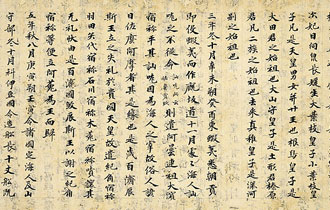Pages |
This type of cooking is rarely eaten today, except in some wedding and funeral banquets and at temples.
By the 15th century, many of the basic food eaten by the Japanese today had made their debut, including shōyu (soy sauce), miso (fermented soybeans), and tofu. During the Edo period, honzen ryōri was gradually refined, with a great emphasis being placed on methods of cutting and other procedures.
Another type of Japanese cooking is called chakaiseki. Chakaiseki refers to a meal served after a tea ceremony. The frugality in this type of meal symbolized the essence of chadō (a.k.a. sadō; the way of tea). The ritual aspect of chakaiseki, as well as the tea ceremony that precedes it, was formalized by Sen no Rikyū (1522-1591), a master of tea who formalized many tea rituals and who served two pivotal war lords, Oda Nobunaga (1532-1582) and Toyotomi Hideyoshi (1537-1598). In chakaiseki, a meal consisted of small servings of rice, and miso soup, and several dishes served in groups or in sequence, each having a very strong emphasis on taste, use of seasonal ingredients, with a distinction between hot and cold dishes. A meal concludes with warmed sake, followed by a soup made of rice stuck to the bottom of the pot (which embodies a principle of frugality), and pickles.
The third type of food is called kaiseki ryōri. This style of serving food originally referred to meals served at poetry parties where the participants gathered compose renga (linked waka poems), a type of gathering that was popular in the Edo period (1604-1868). The meal began with a soup with an odd number of side dishes (an influence from honzen ryōri). The guest would eat and drink sake in an informal setting at his leisure. Rice, pickles, and dessert (e.g. Japanese sweets, fruit), and tea are served, with the tea signaling the end of a meal. Today, in high class restaurants and ryōtei (exclusive Japanese restaurants), this has become the normal progression of a meal.
Many changes in Japanese victuals took place in the Edo period (1604-1868). In early Edo, one rice dish became very popular. It was called Narachameshi (named for the ancient Japanese capital of Nara, where the dish supposedly originated), which was rice, cooked in tea and stock, then served in a bowl with toppings. In the beginning of the 18th century, there were only a few restaurants in Edo, and if one wanted to eat out, it would most likely be at any number of street stalls, numerous in Nihonbashi and Asakusa districts. Soon after, townsmen became more sophisticated about food, as shown by an increasing number of restaurants and cookbooks that became widely available. Even cookbooks about foreign (e.g. Western) cuisine (Spanish, Portuguese and Dutch, cultures to which the Japanese then had access) were written.
A sensibility such as iki (certain stylishness cultivated by fashionable Edo dandies), popularized by the townsmen of Edo in the late 18th and early 19th centuries, also dictated how and when something should be eaten. For instance, lowering all of soba noodles in the dipping sauce was thought to be boorish; a true man of style will only let the sauce touch a small part of the soba. Food unrelated to such sensibilities was avoided at all cost. As townsmen and merchant culture became stronger with the power of the ruling class of samurai on the wane, seasonings like sake, mirin (sweet sake for cooking), shōyu became more widely used among the populace during this time. Teahouses and ryōriya opened along major highways and in towns. Specialty stores selling soba, udon (wheat noodles served in soup or with a dipping sauce), tenpura and such increasingly flourished in urban centers like Edo and Osaka.
Pages |











